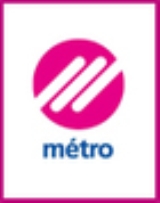
Lausanne Metro
Encyclopedia
The Lausanne Metro system includes two lines in Lausanne
, Switzerland
, owned by two distinct companies and operated by a third. The Line M1 is a light metro
, while the Line M2 is a fully automated metro which opened on 27 October 2008. A third line M3 is in planning. Lausanne has replaced Rennes
as the smallest city in the world to have a full metro system.
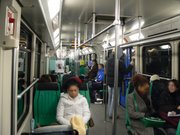 The Lausanne Métro Line 1 was opened on 24 May 1991. The line is owned by a company named TSOL (Tramway du Sud-Ouest lausannois) and this acronym is widely used by the commuters who use the line. Trains on the line are operated by the Transports publics de la région lausannoise (TL, formerly Tramways Lausannois). The M1 is a light metro with only three underground stations.
The Lausanne Métro Line 1 was opened on 24 May 1991. The line is owned by a company named TSOL (Tramway du Sud-Ouest lausannois) and this acronym is widely used by the commuters who use the line. Trains on the line are operated by the Transports publics de la région lausannoise (TL, formerly Tramways Lausannois). The M1 is a light metro with only three underground stations.
The line, which is 8 km (5 mi) long, links the centre of Lausanne
, the major Universities (EPFL
, UNIL
) and Renens
. The line is generally single track
. At most stations a passing loop
is provided to allow trains to pass, and a dedicated platform is provided for each direction. Exceptions to this are Bassenges, UNIL-Sorge and Provence stations, where the line is still single track serving one bidirectional
platform.
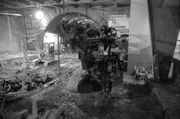
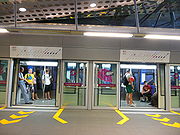
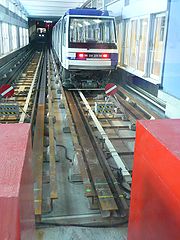 The Lausanne Métro Line M2 uses the track formerly used by the Lausanne-Ouchy
The Lausanne Métro Line M2 uses the track formerly used by the Lausanne-Ouchy
, and then a brand new extension towards Epalinges
, crossing the whole city of Lausanne from north to south.
is able to climb at high speed the Lausanne slopes (12% in some places ; 5.7% average on the whole line).
and a dedicated station personnel assists commuters.
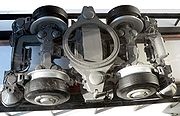
(¹) Calculated with an average of 70 kg per passenger.
. More than 500 m³ of debris (water and earth) fell into the tunnel, forming a huge fifteen metre gap. The area was completely evacuated for a few days and consolidation and geological analysis work started. A large pocket of water had not been noticed during the initial explorations.
Repair work lasted for a few months. The incident fortunately had no major consequence; nobody was in the area of the collapse which had heavily damaged a shopping mall. Part of the budget had been allocated for such risks and the deadline for the construction in December 2008 was not directly affected.
On 27 October 2006, a construction worker died from injuries. He had fallen a few days before on the construction site at the level of the entrance of the CHUV
.
On 28 July 2008 a high level manager for Alstom
who had responsibility for the security system for the new lines was found hanging in the stairwell at the entrance to the Vennes station of the M2. The 45-year-old French man's death appeared to have been a suicide.
 The Lausanne-Ouchy railway was inaugurated in 1877 as a funicular. In 1959 the first overhaul took place by transforming the funicular into a rack railway under the name "métro". At that time, Flon and Gare CFF stations were demolished and replaced by concrete underground equivalents. The line was however always nicknamed "La Ficelle" (The String) by its users due to its funicular past and circulation above ground in the greenery for more than half of its run.
The Lausanne-Ouchy railway was inaugurated in 1877 as a funicular. In 1959 the first overhaul took place by transforming the funicular into a rack railway under the name "métro". At that time, Flon and Gare CFF stations were demolished and replaced by concrete underground equivalents. The line was however always nicknamed "La Ficelle" (The String) by its users due to its funicular past and circulation above ground in the greenery for more than half of its run.
Connected to the Flon facilities, the freight trains from the main station to the storage area of the harbour (in Flon) travelled through this line until the construction of a direct connection between the freight station of Sébeillon and the Flon valley in 1954.
The line was finally closed to all traffic on 22 January 2006. The rolling stock will be sold to the French city of Villard-de-Lans
which foresees the construction of a new rack railway, La Patache to ensure a link between the center of Villard and Le Balcon de Villard in 2008.
A bus service was put into operation to replace "La Ficelle" until the opening of the new metro M2. This service was called Métrobus (MB): the south loop linked Ouchy to the CFF station and the north loop linked the station to Montbenon (which is located right above the Flon area).
Lausanne
Lausanne is a city in Romandy, the French-speaking part of Switzerland, and is the capital of the canton of Vaud. The seat of the district of Lausanne, the city is situated on the shores of Lake Geneva . It faces the French town of Évian-les-Bains, with the Jura mountains to its north-west...
, Switzerland
Switzerland
Switzerland name of one of the Swiss cantons. ; ; ; or ), in its full name the Swiss Confederation , is a federal republic consisting of 26 cantons, with Bern as the seat of the federal authorities. The country is situated in Western Europe,Or Central Europe depending on the definition....
, owned by two distinct companies and operated by a third. The Line M1 is a light metro
Light rail
Light rail or light rail transit is a form of urban rail public transportation that generally has a lower capacity and lower speed than heavy rail and metro systems, but higher capacity and higher speed than traditional street-running tram systems...
, while the Line M2 is a fully automated metro which opened on 27 October 2008. A third line M3 is in planning. Lausanne has replaced Rennes
Rennes
Rennes is a city in the east of Brittany in northwestern France. Rennes is the capital of the region of Brittany, as well as the Ille-et-Vilaine department.-History:...
as the smallest city in the world to have a full metro system.
Line M1

The line, which is 8 km (5 mi) long, links the centre of Lausanne
Lausanne
Lausanne is a city in Romandy, the French-speaking part of Switzerland, and is the capital of the canton of Vaud. The seat of the district of Lausanne, the city is situated on the shores of Lake Geneva . It faces the French town of Évian-les-Bains, with the Jura mountains to its north-west...
, the major Universities (EPFL
École polytechnique fédérale de Lausanne
The École polytechnique fédérale de Lausanne is one of the two Swiss Federal Institutes of Technology and is located in Lausanne, Switzerland.The school was founded by the Swiss Federal Government with the stated mission to:...
, UNIL
University of Lausanne
The University of Lausanne in Lausanne, Switzerland was founded in 1537 as a school of theology, before being made a university in 1890. Today about 12,000 students and 2200 researchers study and work at the university...
) and Renens
Renens
Renens is a municipality in the canton of Vaud, Switzerland. It is located in the district of Ouest lausannois, and is a suburb of the city of Lausanne. It is the fourth largest city in the canton. It is considered a very multiethnic town, as more than 50% of the inhabitants are resident foreign...
. The line is generally single track
Single track (rail)
A single track railway is where trains in both directions share the same track. Single track is normally used on lesser used rail lines, often branch lines, where the traffic density is not high enough to justify the cost of building double tracks....
. At most stations a passing loop
Passing loop
A passing loop is a place on a single line railway or tramway, often located at a station, where trains or trams in opposing directions can pass each other. Trains/trams in the same direction can also overtake, providing that the signalling arrangement allows it...
is provided to allow trains to pass, and a dedicated platform is provided for each direction. Exceptions to this are Bassenges, UNIL-Sorge and Provence stations, where the line is still single track serving one bidirectional
Bidirectional
The term "bidirectional" may refer to:*Anything that can move in two directions*A roadway that carries traffic moving in opposite directions*A tram or train or any other vehicle that can be controlled from either end and can move forward or backward with equal ease without any need to be turned...
platform.
Line M2



Métro Lausanne-Ouchy
The Métro Lausanne – Ouchy or Métro-Ouchy was a rack railway which linked the lakeside at Ouchy with the main railway station in Lausanne and the core of the city at Flon. The system also included a parallel line between the railway station and Flon...
, and then a brand new extension towards Epalinges
Epalinges
Epalinges is a municipality in the district of Lausanne in the canton of Vaud in Switzerland.It is a suburb of the city of Lausanne.-Geography:...
, crossing the whole city of Lausanne from north to south.
History
- Complementary enquiry : September 2001
- Decision by the State Council : June 2002
- Funding requested from the High Council : September 2002
- Popular vote : end 2002
- Metro-Ouchy operations stopped : January 2006
- Duration of construction : 4 to 5 years
- Official Inauguration : 18 to 21 September 2008
- In operation from : 27 October2008
Technical
- Mostly in tunnel.
- Rubber-tyredRubber-tyred metroA rubber-tyred metro is a form of rapid transit system that uses a mix of road and rail technology. The vehicles have wheels with rubber tyres which run on rolling pads inside guide bars for traction, as well as traditional railway steel wheels with deep flanges on steel tracks for guidance through...
metroRapid transitA rapid transit, underground, subway, elevated railway, metro or metropolitan railway system is an electric passenger railway in an urban area with a high capacity and frequency, and grade separation from other traffic. Rapid transit systems are typically located either in underground tunnels or on...
with the steepest slopes in Europe.
Characteristics of the line
- 3.7 miles (6 km) from OuchyOuchyOuchy is a commune, port, and popular lakeside resort located south of the city of Lausanne in Switzerland at the edge of the Lake Léman ....
to EpalingesEpalingesEpalinges is a municipality in the district of Lausanne in the canton of Vaud in Switzerland.It is a suburb of the city of Lausanne.-Geography:...
, including 1 mile (1.5 km) replacing the former Lausanne-Ouchy. - 14 stations. slope (375 metres) slope.
- 5.7% slope average with maximum of 12%. The constraints in braking distance and deceleration is such that the M2 can travel faster upwards than downwards.
Performances
- 25 millions passengers/year (forecast).
- 37 000 jobs serviced.
- 37 mph (60 km/h) top speed.
- 18 minutes from one end of the line to the other.
- Up to 6 600 passengers/hour in each direction.
- One train every 3 minutes between CFF Station and La Sallaz (Every 6 minutes at the rest of the line).
A rubber-tyred metro
A Rubber-tyred metroRubber-tyred metro
A rubber-tyred metro is a form of rapid transit system that uses a mix of road and rail technology. The vehicles have wheels with rubber tyres which run on rolling pads inside guide bars for traction, as well as traditional railway steel wheels with deep flanges on steel tracks for guidance through...
is able to climb at high speed the Lausanne slopes (12% in some places ; 5.7% average on the whole line).
Automated metro
The Line M2 is entirely automated, managed from a central command station. This means that the operation is cheaper and that allows more adaptability during peak hours. The stations are equipped with platform screen doorsPlatform screen doors
Platform screen doors and platform edge doors at train or subway stations screen the platform from the train. They are a relatively new addition to many metro systems around the world, with some platform doors retrofitted rather than installed with the metro system itself. They are widely used in...
and a dedicated station personnel assists commuters.
A separated right of way line
The M2 runs on its own right-of-way, with a double track (except in the tunnel under the CFF station due to high costs), underground for most (70%) of the route. The metro is the ideal solution to the security and congestion problems of the urban public transportation, since the subway can run without interfering with surface traffic.Safe and practical stations
The underground stations are located as close as possible to the surface. They are equipped with stairs, lifts and facilities for handicapped people. The Lausanne slopes have been used to create multi-level access, make ramp access easier and take advantage of natural light as much as possible .Trains

- Articulated vehicles with 4 powered bogies.
- 222 passengers, 62 seated.
- Rubber-tyred metroRubber-tyred metroA rubber-tyred metro is a form of rapid transit system that uses a mix of road and rail technology. The vehicles have wheels with rubber tyres which run on rolling pads inside guide bars for traction, as well as traditional railway steel wheels with deep flanges on steel tracks for guidance through...
with lateral guidance based on the MP 89MP 89The MP 89 is a rubber tired variant of electric multiple units used on Paris's Métro system. Designed by Roger Tallon, two types are built by GEC Alsthom for service on Line 1, 4, and 14.-History:...
from Paris MétroParis MétroThe Paris Métro or Métropolitain is the rapid transit metro system in Paris, France. It has become a symbol of the city, noted for its density within the city limits and its uniform architecture influenced by Art Nouveau. The network's sixteen lines are mostly underground and run to 214 km ...
. - Fully automated (MeteorParis Metro Line 14Line 14 of the Paris Métro system connects the stations Saint Lazare and Olympiades on a north-west south-east diagonal across the centre of Paris. It is the twelfth busiest of sixteen lines on the network, and as of 2011, the only one to be operated completely automatically; the second such line...
).
Technical data of the trains
- Length of a train : 34 yards (30.68m)
- Length of a car : 15 yards (15.34m)
- Width of a car : 7 ft (2.45m)
- Height of the car wrt to ground level: 11 ft (3.47m)
- Mass of an empty train : 57 316 kg
- Mass of a train at maximum load (4 p/m²) : 72 856 kg (¹)
- Width of the access doors : 5 ft (1.65m)
- Height of the access doors : 6 ft (1.9m)
(¹) Calculated with an average of 70 kg per passenger.
Delivery of the trains
The first train was delivered on 2 March 2006 in Lausanne. Since then, all the other trains have been delivered at a rate of two per month. When they arrived, the trains were stored in the CFF storage of Lausanne. Then, by autumn of 2006, the subway workshop facility having been completed, the vehicles were moved finally to the Vennes facility.Accidents
On 23 February 2005, part of the tunnel under construction collapsed under the Saint-Laurent square in the centre of LausanneLausanne
Lausanne is a city in Romandy, the French-speaking part of Switzerland, and is the capital of the canton of Vaud. The seat of the district of Lausanne, the city is situated on the shores of Lake Geneva . It faces the French town of Évian-les-Bains, with the Jura mountains to its north-west...
. More than 500 m³ of debris (water and earth) fell into the tunnel, forming a huge fifteen metre gap. The area was completely evacuated for a few days and consolidation and geological analysis work started. A large pocket of water had not been noticed during the initial explorations.
Repair work lasted for a few months. The incident fortunately had no major consequence; nobody was in the area of the collapse which had heavily damaged a shopping mall. Part of the budget had been allocated for such risks and the deadline for the construction in December 2008 was not directly affected.
On 27 October 2006, a construction worker died from injuries. He had fallen a few days before on the construction site at the level of the entrance of the CHUV
University Hospital of Lausanne
The University Hospital of Lausanne , in Lausanne, is one of the five university hospitals in Switzerland.- External link :...
.
On 28 July 2008 a high level manager for Alstom
Alstom
Alstom is a large multinational conglomerate which holds interests in the power generation and transport markets. According to the company website, in the years 2010-2011 Alstom had annual sales of over €20.9 billion, and employed more than 85,000 people in 70 countries. Alstom's headquarters are...
who had responsibility for the security system for the new lines was found hanging in the stairwell at the entrance to the Vennes station of the M2. The 45-year-old French man's death appeared to have been a suicide.
Possible extensions
The end station Les Croisettes has been designed to allow a future extension of the line to the north towards Epalinges-Village, or even Le Chalet-à-Gobet.Line M3
A line M3 is proposed to serve the new development area of La Blécherette and the west of Lausanne (Malley, Renens Bussigny). Line M3 could be a metro similar to the M2 and would be in correspondence with M1, M2 and LEB railway at the station Lausanne-Flon. The M3 could take over the M2 line from Ouchy to Lausanne Gare and a new terminus for the M2 would be established.Former Lausanne-Ouchy line

Connected to the Flon facilities, the freight trains from the main station to the storage area of the harbour (in Flon) travelled through this line until the construction of a direct connection between the freight station of Sébeillon and the Flon valley in 1954.
The line was finally closed to all traffic on 22 January 2006. The rolling stock will be sold to the French city of Villard-de-Lans
Villard-de-Lans
Villard-de-Lans is a commune in the Isère department in south-eastern France.The town is a centre for skiing in winter and hiking and hot air ballooning in other seasons.-1968 Winter Olympics:...
which foresees the construction of a new rack railway, La Patache to ensure a link between the center of Villard and Le Balcon de Villard in 2008.
A bus service was put into operation to replace "La Ficelle" until the opening of the new metro M2. This service was called Métrobus (MB): the south loop linked Ouchy to the CFF station and the north loop linked the station to Montbenon (which is located right above the Flon area).
Network
- 2 parallel lines
- Ouchy - Jordils - Montriond - CFF Station - Flon (Métro-Ouchy)
- CFF Station - Flon (Métro-Gare)
Characteristics
- Ouchy - Flon
- length 1568 yards (1482m)
- altitude differential 106 m
- slope 11,6%
- train every 8 minutes
- CFF Station - Flon
- length 318 m
- altitude differential 37 m
- slope 12%
- continuous circulation without timetable
History
- 1877, creation of the funicular Ouchy - CFF Station - Flon
- 1879, creation of the funicular CFF Station - Flon, parallel to the initial one
- Traction cables driven by water turbines in the top station
- 1954, transformation of the section CFF Station - Flon to the rackRack railwayA rack-and-pinion railway is a railway with a toothed rack rail, usually between the running rails. The trains are fitted with one or more cog wheels or pinions that mesh with this rack rail...
mode - 1958, transformation of the section CFF Station - Flon to the rackRack railwayA rack-and-pinion railway is a railway with a toothed rack rail, usually between the running rails. The trains are fitted with one or more cog wheels or pinions that mesh with this rack rail...
mode - 1984, sold to the city of Lausanne
- 22 January 2006, end of the operations to allow the conversion into Metro M2 and extension to EpalingesEpalingesEpalinges is a municipality in the district of Lausanne in the canton of Vaud in Switzerland.It is a suburb of the city of Lausanne.-Geography:...
- 19 September 2008, inauguration of the M2 line

